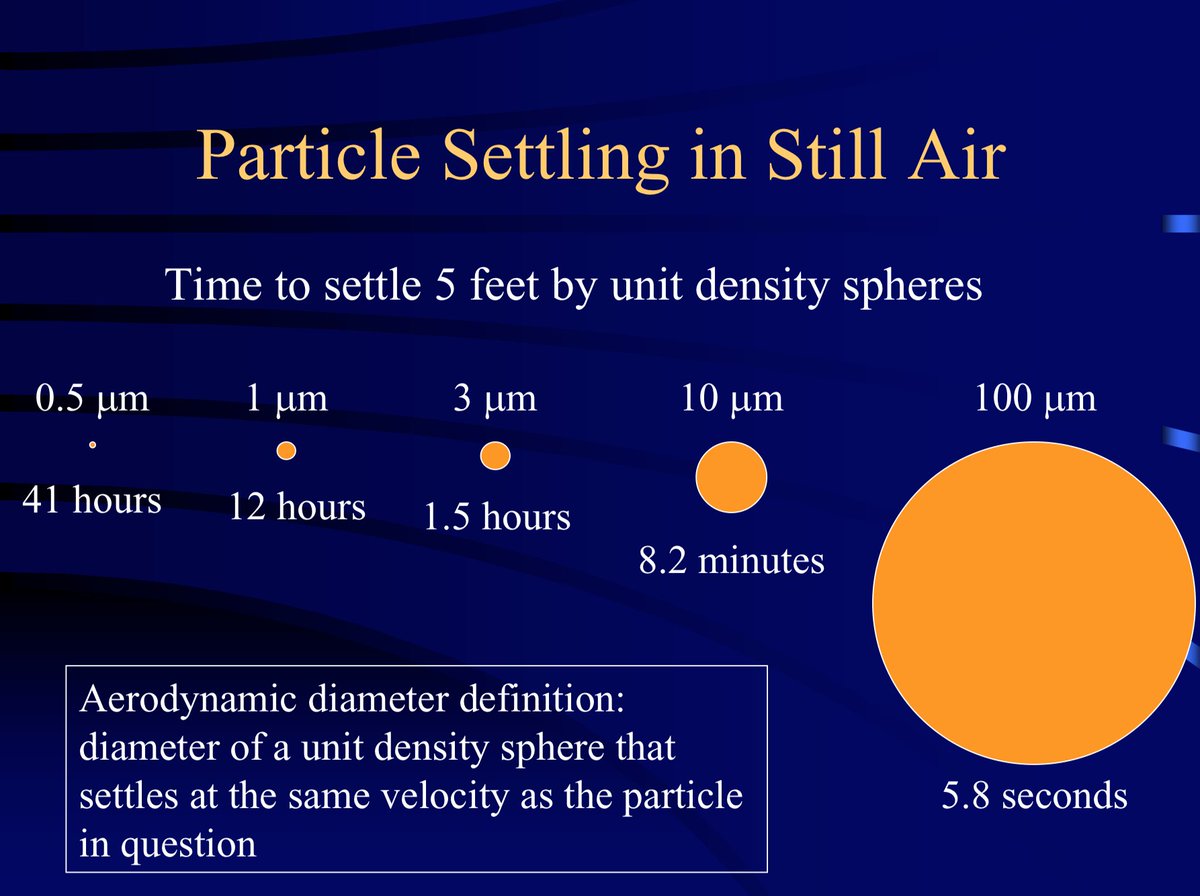Thread: more referenced aerosol discussion published in... the globe and mail? The authors deserve credit for presenting some evidence from both sides, but... https://www.theglobeandmail.com/canada/article-how-does-covid-19-spread-the-controversy-and-the-evidence/">https://www.theglobeandmail.com/canada/ar...
It is disheartening to see continued misunderstanding of the size threshold defining an aerosol. It is well established that droplets/droplet nuclei up to 100um remain suspended in air for as long as 5-6 seconds before settling - potentially long enough to inhale at close range.
https://www.cdc.gov/niosh/topics/aerosols/pdfs/Aerosol_101.pdf">https://www.cdc.gov/niosh/top...
It’s true that only droplets less than 5-10um can make it all the way to the tracheobronchial tree and alveoli, but using this as the aerosol threshold conflates where the droplets deposit with how they got there.
Does anyone doubt that droplet deposition in the naso/oropharynx or larynx is potentially important?
Surely proponents of almost exclusive ballistic droplet transmission don’t doubt this because the superficial boundaries of these sites (along with the conjunctivae) are understood to be the location of mucous membrane contact in ballistic droplet transmission, and yet...
Every time we exclude consideration of droplets/droplet nuclei between 5-10 and 50-100um as aerosols, we are ignoring their potential to infect by inhalation.
The truth is, very few droplets larger than this are produced so it’s kind of important to understand that the vast majority of respiratory droplets remain suspended in air for long enough to inhale and are therefore, by definition, aerosols.
https://bmcpulmmed.biomedcentral.com/articles/10.1186/1471-2466-12-11">https://bmcpulmmed.biomedcentral.com/articles/...
https://bmcpulmmed.biomedcentral.com/articles/10.1186/1471-2466-12-11">https://bmcpulmmed.biomedcentral.com/articles/...
What of the evidence supporting ballistic droplet transmission? Some are hanging their hat on historical dogma, case reports and anecdotal (unpublished) clinical experience...
In a disease where ~10% of infections lead to ~80% of transmission events, and cases most commonly cause zero secondary transmissions while some transmit to dozens, case reports are, to say the least, not particularly reassuring arguments against aerosol transmission.
https://twitter.com/DFisman/status/1293364073929887744">https://twitter.com/DFisman/s...
It’s also clear that high overdispersion (low k) is a key feature driving the pandemic. https://twitter.com/BillHanage/status/1292298040066355201">https://twitter.com/BillHanag...
Another common misconception: epidemiology demonstrating that close contact is important for transmission supports the ballistic droplet route (spoiler: it either doesn’t discriminate vs aerosol or may even suggest aerosol predominance). https://www.sciencedirect.com/science/article/abs/pii/S0360132320302183">https://www.sciencedirect.com/science/a...
“prolonged patient contact was associated with infection in HCWs. These observations are inconsistent with “airborne” transmission” - not so, unless your definition of airborne transmission excludes short-range aerosol transmission (which it shouldn’t).
“airborne” infectious diseases have often been defined as those that can transmit via aerosols over distance and time. These criteria are the most specific and discriminative way to establish that aerosol transmission has occurred, but
***The probability of aerosol transmission will always be higher closer to the source where there is a greater concentration of aerosol in air***
Demonstration of TB transmission to guinea pigs via ducts was necessary to definitively establish its transmission via the aerosol route, but we don’t consider household contact transmission of this obligate airborne pathogen to be something other than airborne at close range.
Similarly, “physical distancing would certainly not work” - on the contrary, it certainly would with an opportunistic airborne pathogen with which one needs to cross a MID threshold via proximity & time to acquire infection.
“But... measles!” Yes, in measles one can cross the MID threshold at greater distance and lesser time. No one is arguing that COVID transmits as easily as measles.
“and clusters of cases would arise where there was no obvious close contact with those infected.”
Well, the percentage of identified cases with no known epi link or no information has remained stubbornly nowhere near zero in Ontario despite greater ability to contact trace in our current lower prevalence environment.
“no strong evidence to support the idea that aerosol transmission is the most common mode of transmission for COVID-19”
I& #39;ll close by commenting on this near straw man; whether it is the most common mode or not, it appears to me to be common enough that it is a significant driver of the pandemic, which is what really matters.

 Read on Twitter
Read on Twitter





